Midsummer Haze is the official 2006 English translation patch for a 2004 freeware Japanese visual novel called Manatsu no Kagerou. The original Japanese novel was created by Sakura Shima and the translation was completed by Kyuuen. Midsummer Haze was submitted to the al|together 2006 visual novel translation festival. I am reviewing Midsummer Haze as part of my project to review nearly all of the 31 Japanese visual novels translated for and contributed to the 2005, 2006, and 2008 al|together project. Midsummer Haze is my 24th review.

You can learn more about my al|together project by reading my project introduction article. That article includes a running list of our completed al|together reviews. I have a dedicated collection post with links to all of our al|together articles, including reviews, essays, and short posts.
For reasons I will explain in my review – Midsummer Haze was something of an ordeal from the actual installation process, which required a significant amount of online searching, to the game itself, which implemented the most ill-conceived mechanics of any novels in the al|together set.
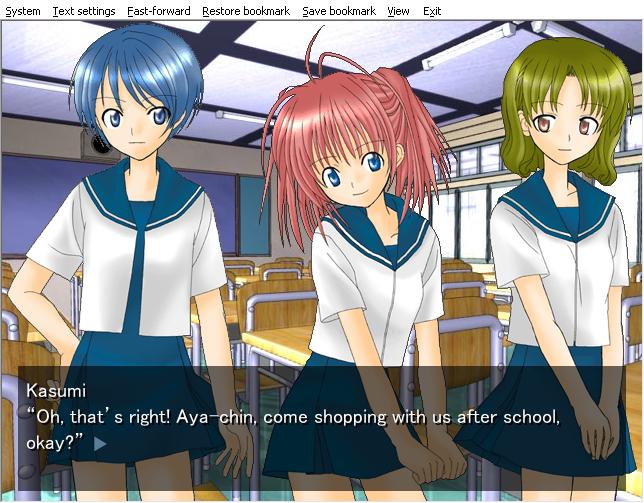
The novel itself, which covers a day in the life of three high school girls who are friends and classmates (it is clear there is something off from the start), initially has two endings which follow directly from a single choice. How then, one may ask, did I have to repeatedly play through it over and over to reach the additional endings? Mechanics… But before we discuss how Midsummer Haze left me in a bit of a late summer haze, let us begin with the basics.
(Note: See my companion article on how I found the original Japanese Manatsu no Kagerou.)
Midsummer Haze Details
English patch
| Title | Midsummer Haze |
| Translator | Kyuuen |
| Release Date | August 2006 |
| Engine | KiriKiri |
| Official Website | al|together 2006 |
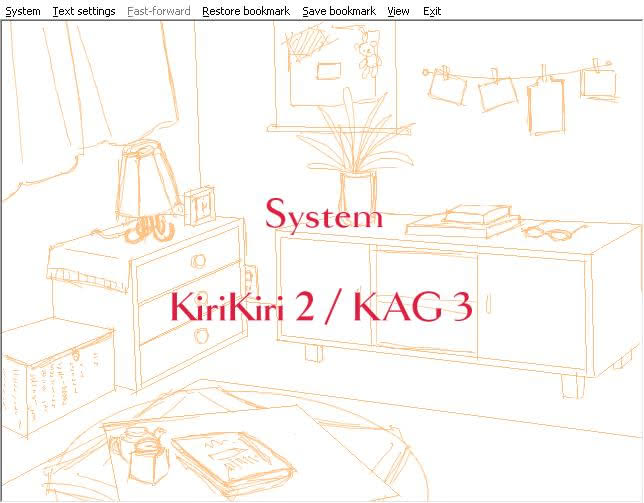
Japanese original
| Title | Manatsu no Kagerou |
| Developer | Sakura Shima |
| Original Release | August 23, 2004 (v 1.00) |
| Final Release | September 18, 2004 (v 1.01) |
| Engine | KiriKiri |
| Original Website | Last Archive (download no longer available) |
(Note that the translation patch applies to the final version 1.01.)

The original Japanese Manatsu no Kagerou, which is required to use the English patch, is no longer available. You may wonder then how I was able to review this novel. I explain, with links, in the next section.
Finding Manatsu no Kagerou
In fact, it is a minor miracle that I was able to play Midsummer Haze at all. I originally planned to tell the whole story of how I found the original Japanese game in this review, but the story is long enough that it deserves its own article, which you will find here. You can also read my Leaflet micropost that I wrote at the time of my greatest al|together research success.
For the purposes of this article, I will point you two unofficial sources for the download.
- Torrent with all al|together 2006 games, including Japanese Manatsu no Kagerou (https://sukebei.nyaa.si/view/3420785)
- Direct download link from MEGA drive (https://mega.nz/folder/CRJHDSpI#z102OFDrpxC19mJcYTf8_w [see 2006 folder])
One could argue that Midsummer Haze is no longer intended to be played (I do not know the circumstances behind why the original download no longer works), and I will note the 2006 terms with the patch prohibit alternative means of distribution of Manatsu no Kagerou other than the official link. As I explain in my companion article, I found the torrent link with all of the al|together 2006 games andI have confirmed that it has the original Japanese Manatsu no Kagerou needed for the English patch to work. I do not maintain the MEGA drive, but it now includes a direct link. My purpose in going through the effort to make the English version of Midsummer Haze playable was to be able to fully chronicle all of the works that made up al|together.
Running Midsummer Haze
Midsummer Haze is written in KiriKiri. Like the other KiriKiri al|together games, it is only available for Windows and it requires a Japanese language environment to run (both the unpatched original and the patched version needs a Japanese environment).
(With our review of Midsummer Haze, we have completed all of the al|together novels which had the Japanese language requirement. See earlier reviews of Collage, io [Christmas Eve], Summer, Cicadas, and the Girl, Until We Meet Again).
It had been a long time since I actually installed Midsummer Haze (I installed it sometime in 2022), so I went through the installation process on Linux again so I could describe it to you here. The principles will be similar for Windows users – minus the steps referencing Lutris and WINE. Note that while I use Lutris as my graphical WINE interface, alternatives such as PlayOnLinux and Bottles should work as well – not to mention plain old WINE through the command line. Other operating systems that can use WINE such as MacOS, BSD, and Haiku should in theory be able to follow my steps, but I have only tested this on Linux.
(Note that there may be other, less sloppy ways of doing this. My method is a bit “hacky,” but I can guarantee my method works on my system.)
For our first step, I created a directory containing nothing but manakage101.exe (the Japanese game) and MidsummerHazeSetup[Kyuuen][AT2006].exe (the patch).
Second, to add a new game to Lutris. I selected “Install a Windows game from an executable” and set the Windows version to Windows XP (however – it should work on newer versions as well).

For the third step, you must configure an installation directory. By default Lutris will suggest a new directory within games with the game’s identifier. For this installation, I created a directory called Test within Games (my real installation is in a different Games subdirectory). WINE users should go with the default.
Fourth, we need to select a setup file. Here, I select the patch rather than the Japanese game. If you are setting this up with WINE, make sure to select the English language patch from the al|together 2006 site as the executable and not the Japanese executable for the game, which should be in the same directory.
Wile Midsummer Haze will require a Japanese language environment to run, the installer started by executing the patch works with English locale settings.
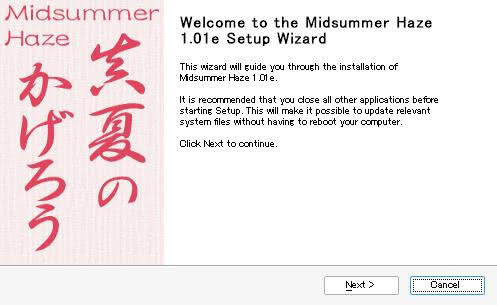
I leave the Destination Folder as default (Windows users may want to change the destination folder, but those of you running WINE should leave it as the default).

Of course, when we try to launch the game, it will fail due to the lack of a Japanese language environment.
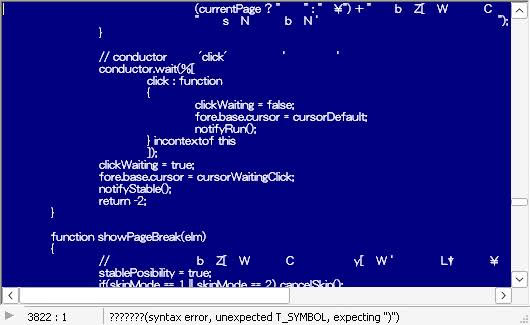
This is fine, however. Close the failed launch and navigate into Lutris’s settings. Change the locale to Japanese in accordance with my previous guide on the subject (which also covers PlayOnLinux and Bottles, the PlayOnLinux section may be relevant to PlayOnMac users).

(I also covered how to change locales in Steam for Linux users who want to use Steam as the installer. Note that installing this through Steam will only work on Windows and Linux.)
Now let us try launching with a Japanese locale…

Perfect! The secret to the installation is having the patch in the same directory as the original Japanese game when you run the Lutris installer. Even though Lutris is installing the game into a different directory, the patch will recognize the original Japanese game and patch it so long as it is in the same directory when you run it. This same logic should apply in Windows cases. Windows users should make sure to enable a Japanese language environment and run the patch from the same directory as the Japanese game. For reference purposes, let me show you what happens if you try to run the installer without the patch in the same directory. Note I am following the exact same steps as before – the only difference is I am running the patch without the Japanese game by its side.
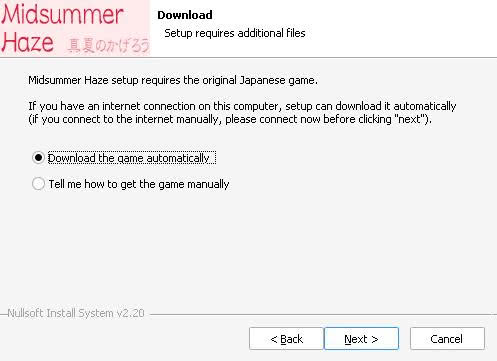
This is where we run into a road block. If the installer does not see the original Japanese game in the same directory, it kindly offers to download the game for you or tell you how to download the game directly. As I explained, the links that the installer knows of are from 2006 and they no longer work. However, it is from the second option in the above screenshot that I figured out the installer would recognize Japanese game if it is in the same directory.
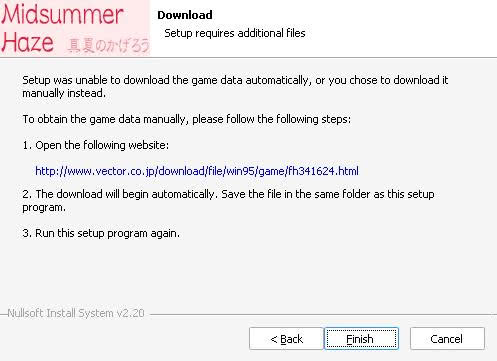
Selecting download fails and causes the installer to shut down.
Thus, before continuing my review, I list the steps to setting up Manatsu no Kagerou. My steps assume you have already configured your WINE set-up for the game if you are not on Windows.
- Run the patch from the same directory/folder as the original Japanese executable
- When you run the game after the executable patches it, make sure that you are using a Japanese language environment – the English version will not work in an English language environment
In the end – the set-up is not too complicated once you have the original Japanese Manatsu no Kagerou executable.
MIDI requirement
As if Midsummer Haze did not present enough challenges, it also uses MIDI for sound. Thus, your computer must be able to handle MIDI for the background music and sound-effects. The procedure can vary based on system, but I wrote an article explaining how I got MIDI sound working on my Arch-based Linux distribution, EndeavourOS. Do note that Midsummer Haze is perfectly playable without background music and sound effects, but I imagine that most people would prefer to have the full experience after going through the trouble of installing it.
General overview of Midsummer Haze
The official al|together 2006 festival page describes Midsummer Haze as follows:
Kasumi’s just a lazy schoolgirl who wants to go shopping with her friends. So why are they acting so nervously around her today?
Granting its brevity, it would be hard to write a better introduction to the story of Midsummer Haze. The player takes the role of Kasumi Nakauchi, who is in fact a lazy high school girl.

We meet her as she rolls out of bed and rushes to get to school. Upon getting to school, she greets her two friends – Chiho and Ayako. While they are friendly, there is something off about how they react to Kasumi. “Nervously” is accurate enough. After school, the three go to the local shopping strip.
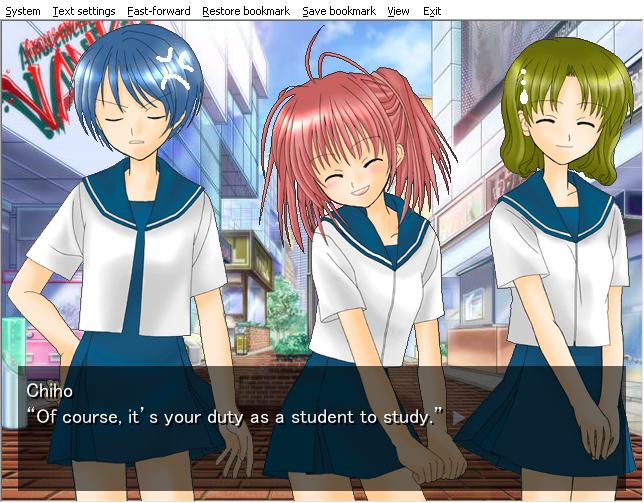
As Kasumi, the player must choose whether to go to the general store or the bookstore. This choice causes the very short story to split in two directions. Both paths show why Chiho and Ayako are acting nervously around Kasumi, but from different perspectives.
Midsummer Haze Review
I will begin with a qualified spoiler un-warning before assessing the various components of Midsummer Haze.
Qualified spoiler un-warning
As usual, I will not spoil the story or twists of Midsummer Haze. For example, I noted above that Kasumi’s two friends are acting nervously around her. The reason for their behavior is revealed after a few minutes of reading, but I will not explicitly discuss the reason in this article.
I will, however, discuss in detail how the central mechanics of Midsummer Haze, which is required for unlocking the third ending, works. While I would ordinarily caution people who are interested in reading the novel to explore it for themselves before reading my review, in this case I will render the opposite recommendation. People who have any interest in reading Midsummer Haze should read my discussion of how the novel works before reading. Why? Well, because otherwise the frustrating central mechanic will most likely add a good chunk of play time beyond what the game’s small word count would suggest or otherwise warrant. Moreover, it would be impossible for me to assess how long it takes to read everything in Midsummer Haze without discussing its peculiar design direction.
In summary – I will explain what is required to see the entire story of Midsummer Haze in a reasonable amount of time , but I will not actually spoil the substance of the story beyond what I already wrote in the introduction.
Game-play and structure
Midsummer Haze is a very short novel with a single choice. The choice arises in the third scene of the game. The player, as Kasumi, must decide whether to go with her friends to the General Store or to the Bookstore. This choice is a defining branch. Each option leads to a different ending. There is only a small amount of reading after the choice. For reference, most people should be able to read to the conclusion of one of the branches without skipping in 5-10 minutes.
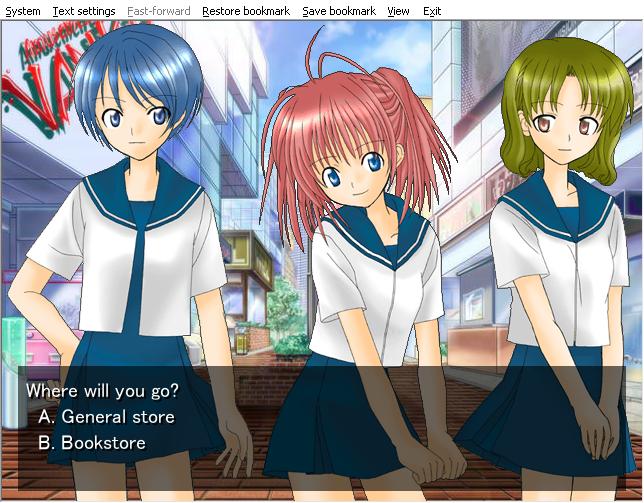
The game’s menu screen has a section for “Endings.” Astute readers will notice that there are three endings listed. Yet the novel has a single branching choice where each choice leads to one ending. We seem to have two endings – not three. Where is the third ending?
To start, seeing both of the first two endings is a prerequisite to seeing the third ending. However, it is far more likely than not that playing through either branch after seeing the first two endings will not show any change because there won’t be an available third ending.
Now we discuss the most absurd mechanic seen in any of the al|together novels.
When the player achieves an ending, the ending is recorded in the Endings menu on the title page. One of the first two endings is listed as X Ending 1 (X is a blank for spoiler purposes). This tips the reader off that the third ending is related to the other ending, which is numbered.
I have played enough novels and seen enough anime to have immediately had a bad feeling when I played through the path which led to the numbered ending a couple of times and saw no change. Before I smashed my head into a wall, I decided to check the Visual Novel Database page for the game to see if anyone had commented on how this works. I found that user zangshark1 published a post on April 26, 2020 (one day before the launch of The New Leaf Journal) titled “for the confused.” Being confused, I clicked onto it. It has a guide for not only the third ending but also for an apparent fourth ending. I was only interested in the elusive third ending at the moment so as to not spoil myself (the user kindly blocked the solutions by default – scroll over to reveal). The solution, as I feared, was to re-do the route in question over and over and over again until you see the third end instead of the abrupt second end.
User zangshark1 reported that he or she had to run through the route “a little over a dozen times” before the third ending triggered. This sounded annoying – but it only takes about 15-20 seconds from the start of the game to the end of the route (with three clicks thrown in) with fast forwarding – so how long could it take? That is when I discovered to my horror that zhangshark1 had been very lucky.
Just to be on the safe side, I decided to start every time from the beginning of the game rather than a save created at the choice point in case the outcome of the route was predetermined on start instead of when the choice was made.
Long story short, after going through the entire route in question 43 times, I finally saw the third ending. I repeat – FORTY-THREE TIMES. After 35 tries, I wondered whether the version of WINE I was using was preventing the event from triggering. I switched. It took eight more tries with my system-default WINE Staging. However, I have no reason to believe that the WINE version makes any difference.
Now even after you see the third ending – which is almost identical to the second ending but with an additional scene – re-playing the route will still spin the roulette of chance instead of showing you the third ending again (tip: make sure to save at the start of the third ending scene if you want to be able to easily re-read it). I decided to see how many tries it would take to trigger ending three again. It took 19 tries on my second attempt. Was that lucky? Maybe that was lucky.
Before writing this review, I wanted to add a bit to my sample. First, from a clean start, I tried again using the same method I did the first time. I unlocked the first two endings and then began playing the game of chance – starting each time from the beginning of the game. I got the third ending on the 30th attempt. Then, starting from another clean save, I tried something simpler and more convenient. After getting the first two endings, I created a save point at the choice and started from the choice instead of the beginning of the game (this saves a click and about 5 seconds of skipping). Doing this, I triggered the third ending on the 28th try, concluding that whether the third ending triggers is determined the moment you make a choice instead of at the start of the game.
So, it took me 43, 19, 30, and 28 tries to trigger the third ending. It had taken zangshark1 a little more than 12. I do not know the exact odds here, but they are clearly way too low.
Fortunately, the third ending is the key to unlocking everything that Midsummer Haze has to offer. Upon seeing the third ending, the player has access to an Extra’s menu with an afterword to the main story narrated by one of the characters and statements from the creator and the translator. The afterword is worth reading as it is essentially part of the story. The creator’s statement makes clear that the game was somewhat of an experiment. The translator’s statement adds some interesting cultural context to one of the main points of the story and is worth reading.

Now, after all of the time and clicking needed to get the third ending, readers may be horrified to see that the Endings screen shows a fourth ending after the third ending is unlocked. Fortunately, the fourth ending is much less troublesome, albeit much like some Easter eggs in The Caged Vagrant, it is not immediately obvious. User zangshark1 on Visual Novel Database explains how to get it. For those of you who suffer to get the third ending and find yourself stuck, I posted the solution in my personal Gitea repository.
(For those looking for an ambiguous hint – sometimes there is a third choice when you are presented with two options.)
Estimated reading time
If it only took three runs to achieve the first three endings, Midsummer Haze would be amenable to a complete reading (extras included) in 20-25 minutes. However. unless those of us who have read it are making some error about the trigger condition for the third ending, Midsummer Haze’s actual reading time to completion depends on how many tries it takes to reach ending three. Had it taken my 19 tries (my best attempt at triggering the third ending), that would have added several minutes assuming I was doing nothing but skipping text in the most optimal way. 43 tries, my worst effort, adds a few more minutes, again assuming you are doing nothing but focusing on re-starting and skipping test as fast as possible.
Visual presentation
Midsummer Haze has simple-but-solid-enough visuals for what it is. Each of the three main girls has a character sprite, and they are the only characters we see through the initially available endings.
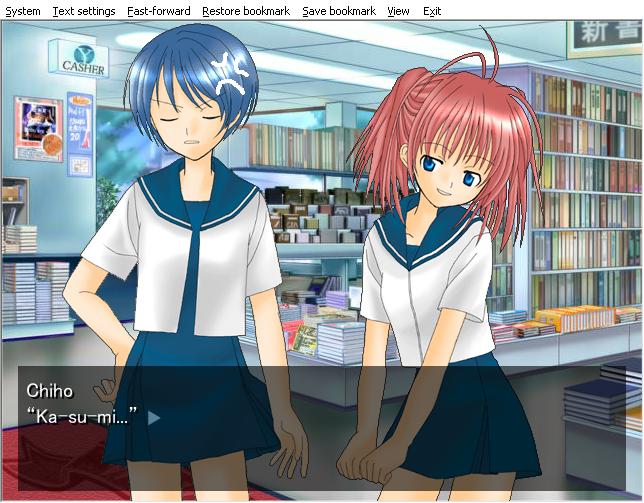
Their designs have a definite doujin novel feel, but the quality is decent and falls toward the middle for the al|together novels we have looked at so far. I found Kasumi’s pose to be a bit odd. Ayako has the best design of the three main girls. While the poses do not change (other than Kasumi changing orientation in one instance), each of the characters has a small number of expressions which are sufficiently sold for the small amount of dialogue. I will also note that the art design modifies the clothes of the three main girls based on their pose. This sort of attention to detail is always welcome.
The novel has a good variety of backgrounds – one for every different setting. The backgrounds are drawn instead of modified photographs.
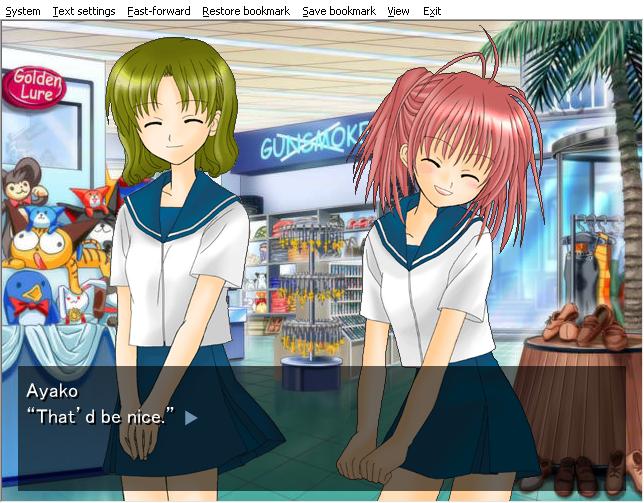
The strongest part of Midsummer Haze’s visuals is the title screen, which is a modified version of Kasumi’s bedroom – which we see in the novel’s opening scene.

Combined with a very good choice of title font, Midsummer Haze has one of the more aesthetic title screens of all of the al|together novels. While this is not a big deal – it makes for a good first impression.
Audio
Midsummer Haze uses standard, freely available background music tracks (I recognized one from Night of the Forget-Me-Nots). The background music selection is fine – it adds little to the novel but the selections are suitable and pleasant enough.
There is a minor issue with two sound effects. In the first scene Kasumi wakes up to her alarm clock. In a later scene, one of the character’s phones goes off. The alarm clock in the opening scene is unexpectedly loud (perhaps too realistic), so make sure that you do not have the volume cranked up when you start the game for the first time (the music is relatively quiet compared to the alarm).
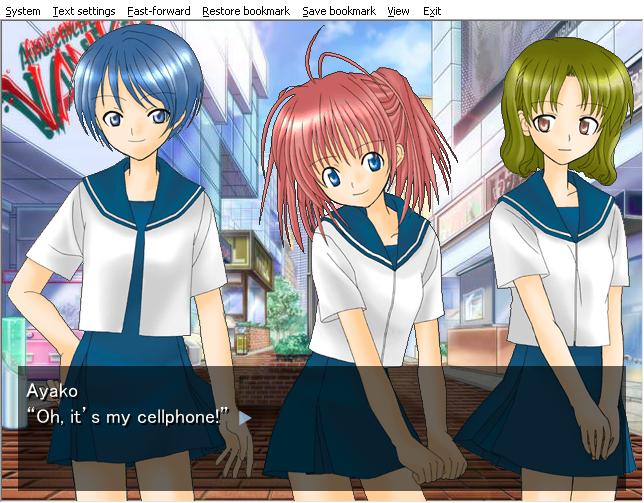
The phone ringing is also quite a bit louder than the music, albeit less piercing than the alarm effect at the beginning of the story.
Translation quality
As always, I preface my review of the translation of The Letter by reminding readers that I do not know Japanese and have not read the original novel. Thus, my translation review addresses how well the English version reads and any obvious points that I can pick up on based on context. I cannot assess the translation’s fidelity to the original.
Midsummer Haze was translated by Kyuuen. The translation reads smoothly from beginning to end and the English text makes the twist – let us call it the reason for Chiho’s and Ayako’s apprehension – clear without bludgeoning the reader over the head. Midsummer Haze is a solid translation effort from beginning to end without any issues that detract from the experience. The only question I had was why the first option in the game’s main choice refers to a “General Store.” I suppose it may make sense in a general way, the characters describe there being fun little things such as stuffed animals and pendants. But it seems closer to a gift shop or a niche store aimed at teenage girls than what I would ordinarily associate with a general store as an American.
Writing and story quality
It is hard to evaluate Midsummer Haze’s story separate from the trial that one must undergo to actually read the entire story. For the purpose of this section, I will try to examine the story as if reaching the third ending and everything that follows from it does not have sadistic conditions.
The story does a solid job off the bat of creating a sense of unease in how Kasumi’s friends are reacting to her. Moreover, it is clear that their unease is in no way malicious – but something else entirely. I will venture that many readers – especially those familiar with some of the common trends in freeware visual novels of the era – will be able to guess the twist before it is revealed clearly in one of the two endings and only slightly less clearly in the other.
The third ending – the one the player must suffer for – is a bit odd (I mostly concur with the assessment of zangshark1, who wrote the guide to the third and fourth endings, on the merits if not his or her wording). While Midsummer Haze plays things straight, the central dramatic event of the third ending is not foreshadowed in the first two and we do not know the characters well enough for it to make much of an impression. Moreover – while acknowledging the struggle, nothing about the third ending acknowledges or ties into the fact that the reader may have had to skip through the second ending 20, 30, or even 40 times to see it. Contrast with Summer, Cicadas, and the Girl, which had a mechanic that required the player to work for the ending but was also structured in such a way that the ending felt like a reward for the effort.
The afterword section is solid and the best-written part of Midsummer Haze. The fourth ending – which I cannot say much about without going into too much detail about the story – is somewhat predictable for the genre but it feels a bit off in light of the first three endings and the afterword of Midsummer Haze. I will note that for the few readers who make it that far – there is an interesting question of how one should interpret the fourth ending, and the question is similar to the question of how to interpret events in the second half of The Letter.
Looking only at the story, Midsummer Haze generally hews closely to a single story (save for a bit of a digression in ending three) and refrains from the temptation to try to do too much that we saw in the somewhat similar Wanderers in the Sky. The story, without more, is neither memorable nor offensive. One shortcoming is that the story lacks a clear message or purpose. It does not tie into the defining mechanic (looping) of Midsummer Haze in the same way that the excellent Summer, Cicadas, and the Girl used its mechanics. It is not obvious that the author had a clear idea for readers to take from the story like what we saw in the similarly short From the Bottom of the Heart. One could argue the fourth ending contains a message – but it is hard to reconcile the fourth ending with the first three endings and their afterword.
Overall review
Some of the best al|together novels are defined by a creative mechanic. Summer, Cicadas, and the Girl makes itself stand out by requiring the player to type an answer to a well-constructed question to reach the true end (or a number of suboptimal endings). Crimsoness defines itself by demanding that the player make increasingly absurd choices against a time limit. Neither Summer, Cicadas, and the Girl nor Crimsoness would be much without their mechanics. But with their fun mechanics, they stand with some of the best entries of al|together.
Midsummer Haze is the reverse case. When viewed under a critical lens, one finds a novel completely broken by its decision to use a random trigger for the third ending. The trigger would have worked fine if the condition was that the player must see the second ending and then trigger the second ending again to see the third. But i by only giving the player a small percentage chance to trigger the third ending by replaying the second ending, it not only mars the experience, but the rewards for finally stumbling on the third ending also do not tie into the effort. If reaching the third ending after re-doing the second 15 times is a decent outcome, the trigger condition is a mess.

(I will venture the trigger condition for ending three is primarily responsible for Midsummer Haze’s unusually poor user score on Visual Novel Database.)
If Midsummer Haze had sane trigger conditions for the third ending, it would be among the novels I recommend to people who are interested in playing through the entire al|together collection – but not a general recommendation beyond its place as a historical curiosity. Granting some of its faults in the third ending and not integrating the fourth ending well enough, Midsummer Haze is a more entertaining read than several novels I looked at, albeit still in the latter half in a final assessment. However, given the amount of effort one must go through to see all of Midsummer Haze, I can only recommend it to the dedicated indie Japanese visual novel fans or those who are particularly interested in translations from the era. I suppose I could also recommend it for people with enough spare time to run it over and over enough to figure out what the actual percentages are for triggering the third ending. However, its requirement that one repeat the second ending over and over ultimately turns what would have been a short and potentially pleasant 15-20 minute visual novel from a different era in game design into a tedious experience.
While I will ultimately remember Midsummer Haze for everything it put me through, it is important to note that the developer did portray the game as something of an experiment in the developer statement in the extras menu. Unfortunately, it appears to be the only game created by Sakura Shima, so there was no second effort to remove its annoyances and to apply what worked in Midsummer Haze.
If you have not done so already, you can read about how I found the Japanese executable required to use the official English Midsummer Haze patch (see article).
Invitation
If anyone finds some rhyme or reason to Midsummer Haze’s mechanic for triggering the third ending let me know via our contact page.